Primavera “Allegory of Spring” – Sandro Botticelli

Click Here to see a full size HD version of the painting
Sandro Botticelli’s Primavera is the painting which sparked my interest in Art History so I felt it fitting that this was the first featured masterpiece on my website. For this analysis of Primavera I have spent a considerable amount of time researching the piece in order to provide all of the information, which I feel is necessary to fully understand and appreciate the painting. What makes a great painting for me is one which ignites a thirst for knowledge and an exploration through history – Primavera is certainly no exception and I am going to take you on a journey which encounters Paganism, ancient mythology and of course my favorite artistic period, The Renaissance…
Please note that I have created several images for this analysis which isolates certain aspects of Primavera – Please make use of the link above to see the painting in its full glory (for best results – use on a touchscreen device for the greater zoom capabilities)
Overview
Name: Primavera / Allegory of Spring
Artist: Sandro Botticelli (1445 – 1510)
Date Painted: 1482
Period: Early Renaissance
Location: Florence, Italy
Dimensions: 203 cm (h) x 314 cm (w)
Medium / Material: Tempera on wooden panel
Current Location: Uffizi Gallery, Florence
Other: Restoration carried out in 1982, headed by Umberto Baldin
Introduction to Primavera
La Primavera or “Allegory of Spring” is one of the most famous works of art to have emerged from the Early Renaissance. Painted by Sandro Botticelli of Florence in approximately 1482, this masterpiece has mystified it’s audience and sparked much debate amongst art lovers and historians alike for centuries. Primavera is an Italian word which translates in English to “Spring” – The theme of Spring is clearly evident throughout this masterpiece but the name “La Primavera” was first termed in 1550 by Giorgio Vasari, Author of The Lives of the Most Excellent Italian Painters, Sculptors, and Architects (A must read for any art enthusiast) when he viewed the painting at Villa di Castello – A country residence of the Medici family. It is impossible to discuss the Renaissance without mentioning the Medici family whose wealth and influence within Florence created a platform for the greatest artists to excel. I am not going to go in to great lengths about the Medici family in this discussion but I do recommend that you carry out your own research. Many of the Renaissance masters largely benefited from the patronage of the Medici and their history is truly fascinating – some of the events surrounding the Pazzi Conspiracy (26 April 1478) are incomprehensible and would seem more at home within a Shakespearian tragedy.
It was initially believed that Primavera was commissioned in 1477 by Lorenzo de’ Medici (Il Magnifico) as a gift to his brother Giuliano to celebrate the birth of his son, Giulio di Giuliano. (Giulio would later go on to become Pope Clement VII, second of four popes to have been of Medici decent) but following the Pazzi conspiracy where Giuliano was murdered (seriously, use the link above and look in to it) the fate of the painting would change course. While this may bare some truth it is widely agreed upon that the painting was born out of alternative origins – in 1975, a household inventory was found which included the Primavera within it’s contents, valued at 100 Lira – what a bargain! The inventory was dated 1498 and was for the Pallazo Medici in Florence which was regsitered to Lorenzo di Pierfrancesco de’ Medici, cousin of Lorenzo the magnificent.
In 1482, Lorenzo di Pierfrancesco de’ Medici married Semiramide Appiani, daughter or Jacopo III – the marriage was arranged by Lorenzo de’ Medici and was seen as a highly lucrative connection between two families of great influence. When we start to look at the composition and theme of Primavera it is clear that the themes of love, fertility and marriage are strongly evident in the painting. The inventory also suggested that the painting had hung in a bedroom as part of a larger piece of furniture above a sofa bed – it is fair to say that this was a relatively intimate location for the painting and gives further support to the theory that Primavera was indeed commissioned by the young Lorenzo di Pierfrancesco as a gift for his quite possibly, apprehensive new bride, Semiramide.
Style, Location and Inspiration
Primavera is painted on wooden panel and measures at 203 cm (w) x 314 cm (h). The painting is housed in the world famous Uffizi gallery in Florence where it has been on display since 1856 – it is believed that it had been placed in a storeroom for many years after it was left to the people of Florence following the death of the last member of the Medici family. The painting had formerly been hidden away from public viewing for almost 400 years at the Medici villa.
The inspiration behind Primavera may be subject to a fair amount of speculation. There are clear themes which we will be evident shortly and the composition has been carefully selected to feature notable characters of clear symbolic meaning. There are also clear references to ancient texts from Fasti and Lucretius. The following extract is from Lucretius’ Book V of De Rerum Natura – You may be forgiven for thinking that this extract was written after Primavera was painted as a description but in fact the text was written almost 1600 years prior:
“Spring-time and Venus come, and Venus’s Boy, (Cupid) the winged harbinger, steps on before, And hard on Zephyr’s foot-prints Mother Flora, sprinkling the ways before them, filleth all, with colours and with odours excellent”
Primavera was painted in Tempera which uses a mixture of coloured pigment with a water-soluble binder, usually egg yolk
Theme of Primavera
I think it is important at this stage to discuss the theme of the painting. Primavera is a secular (non-religious) painting which at the time could have been considered ground breaking – most of the paintings around that time were highly religious with popular themes such as “crucifixions” or “virgin with child” dominating. Not only does Primavera go against the grain in this respect it is also highly Paganistic. Please do not make the mistake of thinking that ”Pagans” were all devil worshipers, Paganism is a broad term which encompasses a wide range of religious beliefs which were usually polytheistic. This was indeed a bold move by Botticelli which would most probably have attracted a certain amount of negative attention from within the church. It is this behaviour however which has become synonymous with the “renaissance man” – many historians debate the origins of the renaissance but there is always commonality amongst the personnel who are discussed. Dante Alighieri, Author of the Divine Comedy (another must read and one of the most influential literary pieces ever written) is often credited with “influencing the renaissance” but as we see in Inferno, (the first book of the Divine Comedy which is an account of Dante’s journey through hell) there is a clear message that Paganism is largely inferior to Christianity. Dante implies that the Paganistic ignorance of Christianity is enough to ensure that all Pagans (including his guide, Virgil) must reside in hell. It is not until we encounter the ideas of Petrarch that this attitude begins to shift. Petrarch was pro-antiquity which lead to his discovery of Cicero’s letters, (Roman Philosopher and Pre-Christianity) and proclamation that such genius meant that not all pagans were bad people. It was this humanistic ideology which paved the way for men like Sandro Botticelli to create Pagan masterpieces such as Primavera and The Birth of Venus.
There are several reoccurring themes which run throughout Primavera including adversity, divinity, sensuality and fertility as we will discuss shortly in the composition. It is however, the themes of love and marriage which resonate strongest throughout the painting – earlier we discussed that the commission was by Lorenzo di Pierfrancesco for his new bride so this is not at all surprising. If we buy in to the fact that Botticelli was commissioned to create a painting for an impending wedding it makes perfect sense to me that he opted for a secular painting consisting of mythical characters. This decision allows him to select from a wide array of Greek and Roman figures to depict the desired expression – had he decided to “go religious” he may have found it more difficult to depict his underlying messages. It is with this in mind that we can start to discuss the composition of Primavera and explore the many messages within.
Another theme which we will encounter within Primavera is Neo-Platonism. Neo-Platonistism is a philosophical ideology which seeks reunion with the divine, away from the physical constraints of earthly matter. Beauty and Love have strong roots within Neo-Platonism as they symbolise a reflection of the ideal – through this ideal we can escape the world of matter and be at one with the divine. Another way to achieve this is to simply escape earth and dwell in the mystical realm – we see this within Primavera as the composition is made up of mystical characters . I will cover this in more detail throughout the composition but it is important to know that Neo-Platonism was popularised during the renaissance by many high officials and philosophers including Cosimo and Lorenzo de Medici. Botticelli himself was a Neo-Platonist and frequent attendee at the court of Lorenzo the magnificent.
The Composition of Primavera
At first glance of Primavera you will notice that the painting consists of 9 characters who have assembled within a lush and floral meadow. It is my strong belief that each of these characters were carefully selected by Botticelli based on their historical stories and what they represent. I do not think that any of the 9 characters have been placed within Primavera purely for aesthetics – Botticelli selected 9 mystical characters for a reason and we can now start to look at this in more detail. As we look at the painting it is clear that the painting should be read from right to left – almost all of the figures are motioning to the left and the large branches on the right hand side seem to drive our focus inwards. A suggested reason for this is that the painting was hung in a room whereby it was always approached from the right hand side – this does seem logical but I have a feeling that Botticelli may have had an ulterior motive…So lets take a look at the characters of Primavera – I have isolated the characters so that we can discuss their presence independently (from right to left of course)
Zephyr, Chloris and Flora
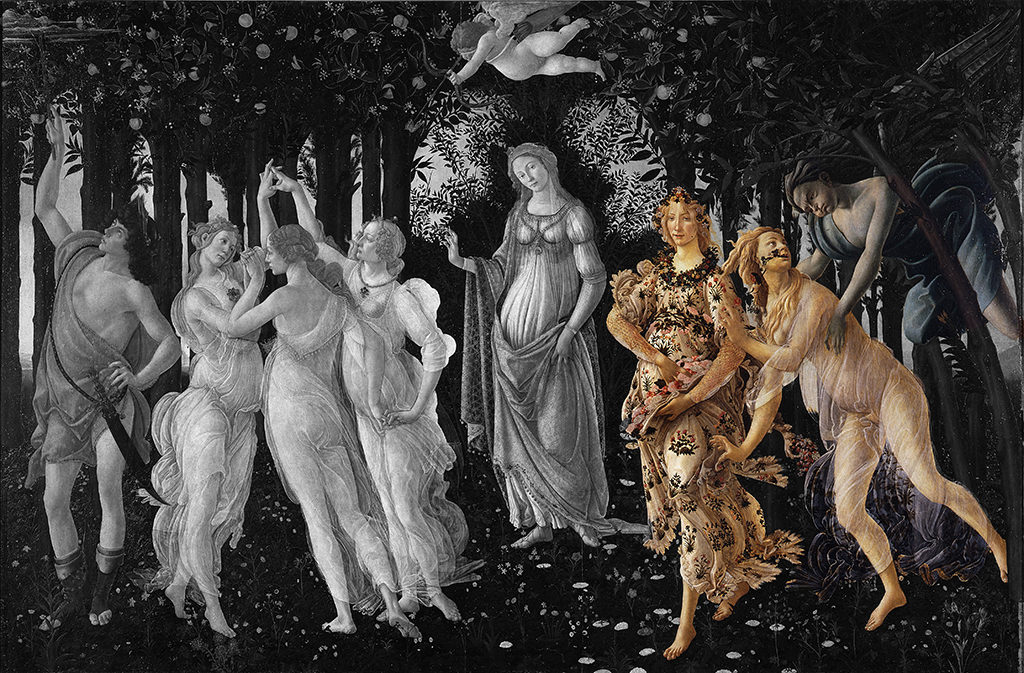
In a painting which is centred around love and marriage it seems almost absurd that we begin with a tale of rape and abduction. On the far right hand side we have Zephyr – the sinister looking, blueish winged fellow who is reaching out through the branches. Zephyr or Zephyrus as he is also known, is the Greek god of the west wind and the young lady he is “reaching” out to is Chloris, Greek Nymph with strong associations to Spring. The story of Zephyr and Chloris is best told by the Roman poet Ovid in book V of his great work “Fasti”. In this literary triumph we are invited to learn about the origins of Flora, Roman goddess of flowers who incidentally, is the lady standing next to Chloris. As Chloris was wondering through Springtime, she was spotted by Zephyr. Overcome by lust and desire Zephyr followed Chloris who sadly could not evade her admirer. Zephyr abducted Chloris and raped her. Consumed by guilt, Zephyr made amends by making Chloris his wife and transforming her in to Flora, the goddess of flowers. The extract from Ovid can be seen below:
I, called Flora now, was Chloris: the first letter in Greek Of my name, became corrupted in the Latin language. I was Chloris, a nymph of those happy fields, Where, as you’ve heard, fortunate men once lived. It would be difficult to speak of my form, with modesty, But it brought my mother a god as son-in-law. It was spring, I wandered: Zephyrus saw me: I left. He followed me: I fled: he was the stronger, And Boreas had given his brother authority for rape By daring to steal a prize from Erechtheus’ house. Yet he made amends for his violence, by granting me The name of bride, and I’ve nothing to complain of in bed. I enjoy perpetual spring: the season’s always bright, The trees have leaves: the ground is always green. I’ve a fruitful garden in the fields that were my dower, Fanned by the breeze, and watered by a flowing spring. My husband stocked it with flowers, richly, And said: “Goddess, be mistress of the flowers.
Back to Primavera we know that 3 of our main characters are steeped in Greek and Roman mythology. I mentioned earlier that there was reason behind each of our characters presence and I believe this one is quite clear. The marriage between Lorenzo di Pierfrancesco de’ Medici and Semiramide was an arranged marriage and much like many 15th century unions, love did not come in to the equation. More so, marriage was used as a way to enhance social status or family connections. In our story we have a female (Chloris) who was not able to choose her husband (Zephyr) yet out of adversity this relationship blossomed in to a happy marriage with a happy bride (Flora). As we learned earlier, Primavera was possibly hung in the bedroom of our married couple. I believe that it would have been most comforting to Semiramide to see how Flora had found happiness with her husband even though the initial circumstances were far from ideal.
I think it is also clear to see in Primavera that Flora is most certainly carrying a child. She is clearly showing the later signs of pregnancy and is clutching at her stomach in a most protective manner – she also has “the glow” that all pregnant women seem to radiate. This would also serve well to remind our bride that her union is intended to be fruitful – the house of the Medici was extremely important and would obviously need to be continued. This can also be supported by the presence of fruit amongst the trees overhead. The oranges (symbol of the Medici family – A nice little touch by Botticelli to impress his employers) do not appear until Chloris has transformed in to Flora – you can see the transformation actually take place as the flowers seem to explode from Chloris’ mouth, personifying Flora as the flower goddess. Flora is also in the act of scattering flowers across the meadow, something that you would expect from the goddess of flowers during Springtime.
Chloris and Zephyr do not seem out of the ordinary, carrying the expressions you would imagine for a woman being abducted and a lustful wind god. Flora on the other hand, carries an expression which is somewhat intriguing. She is the only figure within Primavera to look directly out of the painting. It was not overly common for women to look out of paintings during this period so there was obviously reason behind this. I have read many explanations for Flora’s expression ranging from split personalities of happiness and prostitution. For me, she looks like a woman empowered with happiness and confidence – if we assume that the painting was a gift for Semiramide Appiani, it must have been a great comfort for her to see Flora gazing out of the painting in this way. There are evident connections between Flora and Semiramide which makes it easy to draw parallels – Flora is the bride of Primavera.
Venus
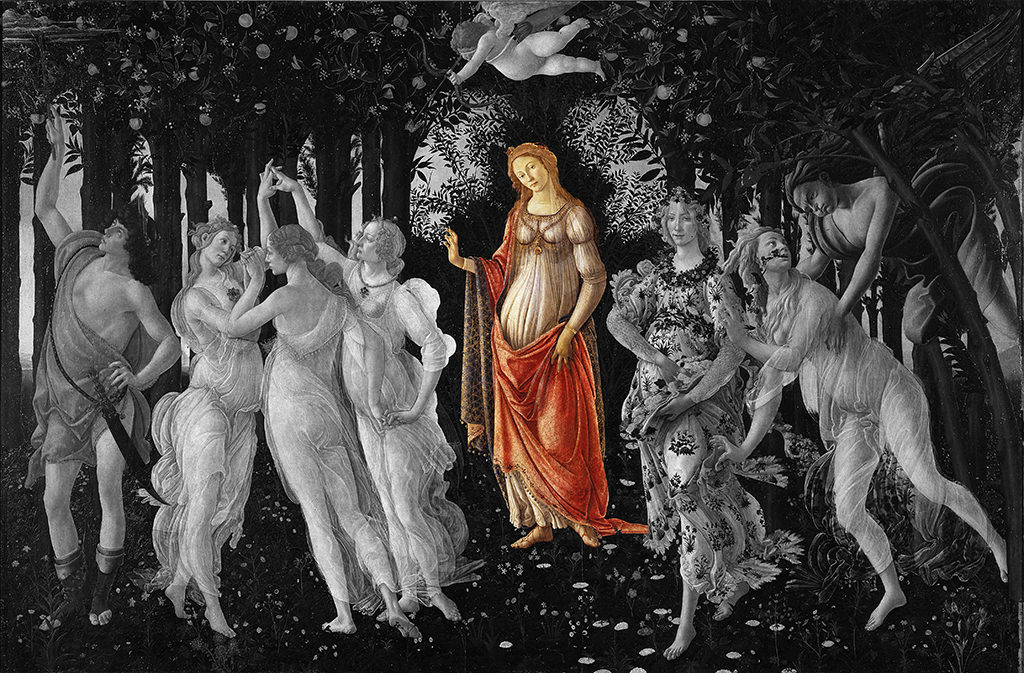
Primavera – Venus
The main focal point and central feature of Primavera is Venus, Roman goddess of love. The fact that Venus is at the center of this masterpiece speaks volumes – all of our figures are in the presence of love and love is presiding over events. Surrounded by myrtle (according to Hesiod, Venus arrives at our shores in a seashell covered in Myrtle) she is situated within a naturally formed arch. Obviously this is no coincidence and is highly symbolic of marital proceedings. At a glance it does appear to me that Venus is standing at a wedding altar waiting to join bride and groom in holy matrimony
Primavera is a secular painting but there are some elements which strike me as mildly religious. Take Venus for instance, if she were to be in a painting on her own she would look very much like the traditional Virgins or Madonna’s being painted at the time. It is also worth noting that the winged child above Venus is in fact Cupid, widely accepted as the son of Venus. Isolating these figures gives us a secular and dare I say it, Paganistic version of a Virgin with child. Venus alone would no doubt have become a masterpiece in its own right – the intricacy of the clothing detail and the beauty of expression is quite exquisite. It would not look out of place within highly religious surroundings. For me, Venus is the standout figure in Primavera commanding your gaze and demanding obedience with her slightest touch. I do believe there are finer artistic triumphs within the painting but in terms of expression and serenity, Venus is unrivaled – a masterpiece within a masterpiece.
The presence of Venus is not only representing love on the physical plane but also a divine love. It is widely accepted that many individuals in high office Florence at this time were followers of Neoplatonism. Members of the Medici family and possibly even to Botticelli himself. Neoplatonism is a tradition of philosophy which is largely influenced by the teachings of Plato and was prevalent during the renaissance. The renaissance fixation with Greek antiquity combined with the modern ideals of Christianity created an environment for Neo-platonism to flourish. As we look at Venus we can see that she has her right hand raised but for no obviously apparent reason. One theory for this is that the goddess of love is favouring the behaviour of those on the left hand side of the painting. On the right hand side of Primavera, we have the animalistic behaviour of Zephyr as he acts on physical impulse to seize Chloris. Once these emotions have expired we can see the transformation in to Flora which represents the sacred love between a man and his wife. On the far left we then have Mercury who we will discuss in greater detail shortly – Mercury seems to be completely ignorant of everyone else in Primavera. His head held high with his back turned to the 3 graces. One explanation for this is that he is displaying a divine love, one which is free from physical urges and operates at a spiritual level. We discussed earlier that the painting should be viewed from right to left, this is given support by the transformation of love from the physical to the divine as we move across Primavera. I believe this pleases Venus or so Botticelli would have us believe – yet another pat on the back from his employers…
Cupid

Primavera – Cupid
As we look to the skies of Primavera we can see that there is a winged child making ready with his bow and arrow. This mystical angelic figure is Cupid, the god of desire and affection – he is also the son of Venus. I think it is easy to assume that Cupid has earned his place in Primavera due to his parentage. His presence along side Venus is a clear depiction of the religious “Virgin with child” theme which was popular at the time but there may be another reason for his inclusion within Primavera.
As we look to the skies of Primavera we can see that there is a winged child making ready with his bow and arrow. This mystical angelic figure is Cupid, the god of desire and affection – he is also the son of Venus. I think it is easy to assume that Cupid has earned his place in Primavera due to his parentage. His presence along side Venus is a clear depiction of the religious “Virgin with child” theme which was popular at the time but there may be another reason for his inclusion within Primavera.
In mythology, Cupid is the god of sexual attraction and desire. The source of his power is his bow and arrow which serves him in 2 ways – Cupid has arrows with blunt tips made from lead and sharp tips made from gold. It is said that if struck with the blunt lead arrow the victim is overwhelmed with an overwhelming sense to flee – there is a description of this within the first book of Ovid’s “Metamorphoses” where cupid accidentally shoots Daphne, the love of Apollo, which eventually leads to her being transformed in to a tree by her father. The more common association with Cupid is the affects of his golden arrows. It is said that to be struck by Cupid’s golden arrow is to be overcome with endless desire.
As we look back at Primavera it is clear that Cupid is aiming his golden arrow at the central figure of the three graces. It is no mistake then that she is now fixated on Mercury – something I will cover in greater detail shortly. It should also be noted that Cupid is blindfolded as he is often depicted – this represents the fact that love itself is blind, an unpredictable feeling which knows no boundaries.
The Three Graces
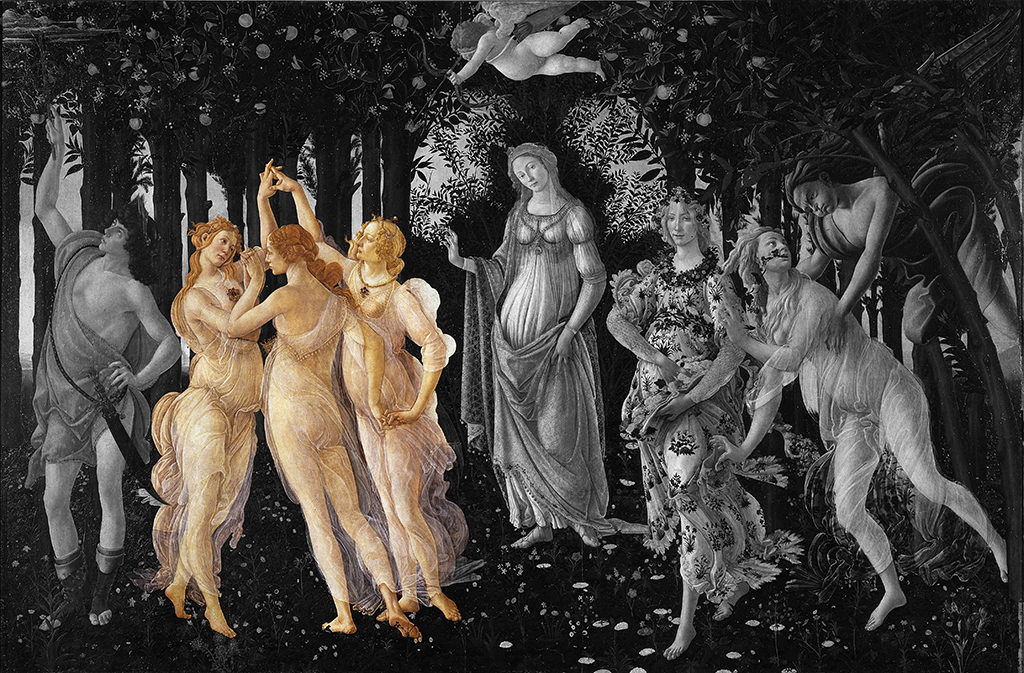
The Three Graces are prevalent characters from Greek mythology and a representation of beauty, fertility, charm, nature and human creativity. The names of the three graces are Aglaea, Eurphrosyne and Thalia and are commonly viewed as Nymphs (female divine spirits or deities). Their presence within Primavera further supports the common themes of love and fertility whilst also complimenting Neo-Platonic beauty and divinity (love which has been converted to a higher plane). The Three Graces are adorned with the jewels of the Medici in yet another tribute to Botticelli’s employers but it is the central figure which requires most attention. The central grace has seemingly been struck by the golden arrow of Cupid and is now fixated on Mercury, who has is back turned and is seemingly oblivious to these events – I will discuss this in greater detail when we take a look at Mercury.
The depiction of The Three Graces is in my opinion the greatest artistic triumph within Primavera. From the almost transparent veils and the delicate intertwining of fingers everything about the graces implies beauty and divinity. If beauty and love spark memories of the ideal divine then we are truly in the presence of Neo-Platonism. As with Venus, if the graces were painted alone they would make a truly wonderful piece of art, another masterpiece within a masterpiece.
Mercury
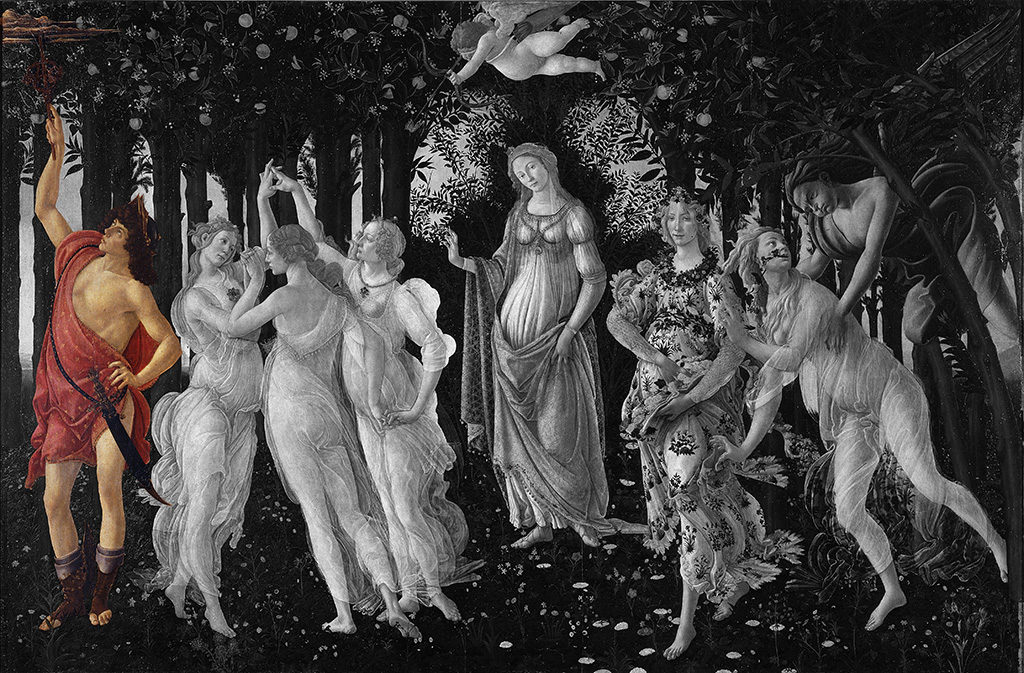
As we look to the left hand side of Primavera we can see a young man who appears to be poking at the clouds with what looks like a golden branch. This is in fact the god of financial gain and commerce, Mercury – we can identify him by his winged sandals and the the golden branch he is holding which is in his Caduceus (not the rod of Asclepius as it is often mistaken for). I suggested earlier that every one is Primavera was there for a reason and Mercury is no exception – Botticelli could have selected any mystical character or ancient mythological god so we need to understand why it was Mercury. If we continue with the theory that Primavera was created as a wedding gift then it stands to reason that Mercury assumes the role of groom. It has been suggested that the figure of Mercury bares resemblance to Lorenzo di Pierfrancesco which I imagine would have been greatly received – Mercury is the messenger of the gods and god of financial gain so the choice of Mercury may well have been Botticelli’s attempts at flattery (something which has been seen throughout the painting), eaither way it is a good choice to represent someone of importance and business acumen.
Once we have established that this character is Mercury then the next logical question should be “What on earth is he doing?”. Mercury is raising his right hand aloft and holding his Caduceus (usually depicted holding it in his left hand but we can forgive Botticelli for this, or who knows? it may be symbolic of something) he seems to be pushing away the clouds, maybe allowing Spring to take over from Winter or one other theory is that he is just keeping in touch with the heavens as his role of messenger. More importantly in Primavera, I think it is interesting to see what Mercury is not doing. Behind him there are what seems to be three semi-naked nymphs and representations of beauty but Mercury is not interested even though one of the graces is completely transfixed on him. This is the clearest demonstration of Neo-Platonism within Primavera as he turns his back on physical emotions and feelings of desire to keep his focus on the divine above.

As I imagine Primavera hanging on the bedroom wall of Lorenzo and Semiramide I find it amusing to think that they are both looking at the painting and smiling…On one hand we have Lorenzo looking up thinking how important and Neo-Platonic he is and then we have Semiramide feeling assured that her husband is not being tempted by the three symbols of beauty behind him.
The Background / Meadow
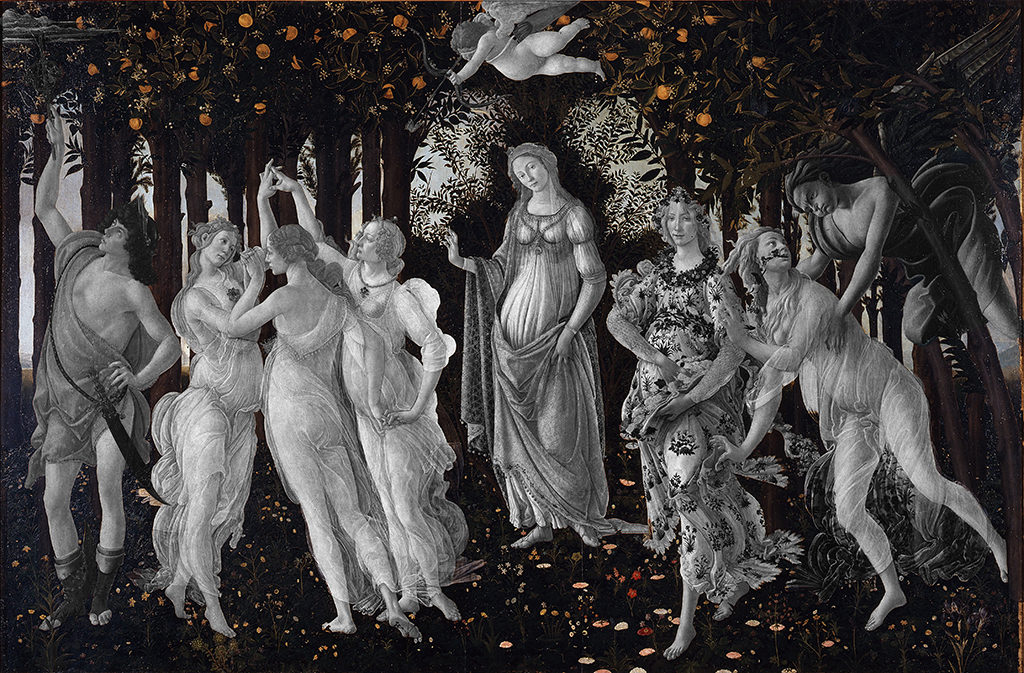
Final Thoughts
First of all I would like to say thank you for taking the time to read this article – I know I can drag on a bit
Primavera is a true masterpiece of the renaissance and one of the most thought provoking compositions to have emerged from this period. To understand it’s full meaning is to go on a journey throughout time and visit some of the most wonderful characters in ancient mythology. Not only does it excel aesthetically, it delivers us with several lessons in ancient history. For anyone who is interested in Art History then this would be a great place to start.
Seeing Primavera in Person
In May 2022, I finally got to see Primavera in real life as it proudly hung on the walls of the Uffizi gallery in Florence. Certain paintings resonate differently with different people and for some reason this one has always been one of my favorites. Seeing it real life is something I will always remember and an experience I have been waiting for for many years.


I love your article! Like you, I have been fascinated by La Primavera for many years and, it is my favorite painting. I saw it, in person, for the first time In June, 2022. There are simply no words to describe the feelings while viewing this masterpiece up close! (I had waited 30 years to see this work – we were supposed to visit the Uffizi in 1993 but, it was closed after that nearby bombing!) I actually shed a few tears of joy. I was so fortunate to see it again this past June and, introduce it to my adult daughter. I hope to visit Florence next year and, will definitely spend more time with this magnificent work of art!
Thank you Kathy…the more you learn about the subject, why it was painted and who it was painted for, the more fascinating the painting becomes.